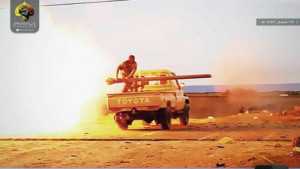
High quality professional videos made by these Islamists are regularly being uploaded to the net, while scenarios for those may vary from sheer presentation (showing the power and military successes of ISIL units), to interviews with fighters and commanders, “ritual” executions of hostages and appeals to the world powers, even scenes of the “peaceful life” of the Caliphate being filmed on a regularly basis. The tool of choice for a successful distribution of these videos is social media which allows for the creation of extremely wide networks, with no single center to be found whatsoever. Experts believe that a total of 90,000 Twitter account owners share the views of ISIL militants or are interested in covering the activities of this terrorist organization in a positive fashion. However, only two thousand of them are owned by members of ISIL. Each of those has from up to 50 thousand subscribers, providing the militants with a handy tool to spread radical ideas across the globe.
The well-known online video platform YouTube serves as the main media platform of these radical fighters. In addition to the “traditional” social networks such as Twitter or Facebook, radicals have recently mastered one of the most popular social services of the day – Instagram. Another popular platform – Ask is being used as an online recruiter tool providing anyone completely anonymously with information of where a future Islamist should travel to receive training and join the ranks of ISIL.
It’s safe to say that the media space that has been created by ISIL in the Internet is extremely diversified. All of these propaganda activities are being controlled by a former Syrian citizen Abu Amr al Shami – a member of the Shura Council, who used to lead Islamists in Aleppo. He supervises the activities of collaborating writers, journalists, filmmakers, bloggers and editors who create electronic publications and monitor media space and social networks. Abu Mohammad al Adnani, known as the Minister of Communications of the Islamic State carries out the functions of an official spokesman for the terrorist group.
Back in 2006, Al Qaeda in collaboration with the Islamic State of Iraq established a media agency,- al-Furqan Institute for Media Production to carry out international propaganda campaigns, which became the center of production for a wide range of media products: films, papers, and information materials for digests for distribution on the Internet. This agency produced and distributed the shocking video of American journalists James Foley and Steven Sotloff being beheaded, just like the video execution of a British citizen David Haines in 2014.
In 2013 ISIL created a media fund, the Ajnad Media Foundation, which specializes in manufacturing and distributing jihadi sermons and hymns, while another media agency I’tisaam Media Foundation, is focusing on making content in the Arabic language, considered in many Western countries a major source of information about ISIL. The majority of its content is published on the site «Jihadology.net», most of which is propaganda pictures, videos and audio recordings.
In 2014 ISIL established a new media center, the Al Hayat Media Center, to target Western audiences and produce propaganda materials in English, German, Russian and French. This media production is aimed at attracting new members to the terrorist group from Western countries or urging local residents to carry out terrorist attacks in the countries of their origin. On top of publishing fact sheets about ISIL such as the «Islamic State Report» and «Islamic State News», it is producing textbooks regarding preparations for terrorists attacks.
Members ISIL are also using such advanced tools of promotion including Android apps, the latest one titled “The Dawn of Glad Tidings” used for the generation of Twitter messages. Once an ISIL supporter is registered in the application, it starts sending propaganda messages on his behalf.
Another tool of promotion of radical ideas in Twitter is hashtags. Hundreds, sometimes thousands of activists at a certain time of the day have been repeatedly using radical hashtags. This method allowed ISIL activists to cheat regarding the results of @ActiveHashtags (a popular tool in Arab Twitter, which publishes the most popular tags of the day).
On top of all this, cyber-space is being used by hackers affiliated with the Islamic State. In particular, according to the security company Group-IB, a special division of the Cyber Caliphate has managed to hack US Central Command accounts on YouTube and Twitter in January of 2015.
The measures to combat the use of social networks and media space by ISIL that have been undertaken by a number of states but has not given any significant results, as the high degree of decentralization of those networks negates the effect of the closure of individual accounts, while anti-spam filters are of little use for the prevention of the spread of links to remote file or video sharing hosts. Under these conditions and in the face of an ever-growing danger of this spreading terrorist threat, some serious legal and technical steps must be taken against this radical propaganda on the Internet.
Vladimir Platov, an expert on the Middle East, exclusively for the online magazine “New Eastern Outlook”
